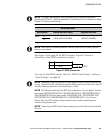
COMMUNICATION
Eaton
®
9130 UPS (700–3000 VA) User's Guide S 164201718 Rev 2 www.powerware.com
59
Programmable Signal Inputs
The UPS incorporates four programmable signal inputs: one RS-232
input, two connectivity card inputs, and one REPO terminal input. See
Figure 18 on page 53 for the locations of the ports. Configure the inputs
with the “Signal Inputs” setting in “User Settings” on page 40.
Table 6 shows the programmable settings for the signal inputs. Table 7
shows the operation logic for the signal inputs.
Table 6. Programmable Signal Inputs
Signal Description
Not Used The input operates only as a serial input (RxD) or has no function.
Force Bypass If active, the UPS is forced to static bypass operation regardless of
the bypass status.
Remote Shutdown If active, the UPS output turns off after a user-defined remote
shutdown delay. The batteries continue charging. Inactive input
does not abort the shutdown countdown and does not cause the
UPS to start up automatically.
Delayed
Shutdown
(and restart)
If active, the UPS output turns off after a user-defined delayed
shutdown delay. The batteries continue charging. Inactive input
does not abort the shutdown countdown but will cause the UPS to
start up automatically if the input voltage exists.
On Generator If active, synchronization is disabled and the UPS transfers to
bypass.
Building Alarm 1 If active, the UPS generates the “Building Alarm 1” alarm.
Table 7. Polarity Options
Input Description
High Active state on high voltage (+Udc) level
Low Active state on low voltage (GND or -Udc) level


















